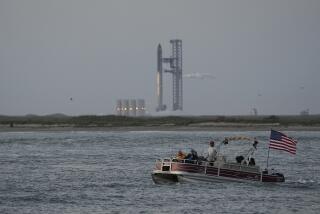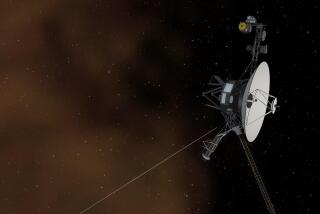America Back in Space With Majestic Launch of Discovery : Mission Helps Heal Scars of Challenger
- Share via
KENNEDY SPACE CENTER, Fla. — After the heartbreak of Challenger and nearly three years of frustration, five men on a ship called Discovery healed an open wound here Thursday.
The shuttle blasted off majestically from launch pad 39B, the same one used by the Challenger, at 8:37 a.m. PDT in the nation’s first manned spaceflight in 32 months.
It was an emotional tour de force for the thousands who watched from the spaceport here. Many wept openly as the craft thundered across the sky.
In the normally sedate control room, workers repeatedly sprang to their feet and threw their arms around each other despite a request from launch director Robert B. Sieck to “try to hold their emotions.”
‘Just Couldn’t Help It’
“They just couldn’t help it,” Sieck said.
The loudest applause came 73 seconds into the flight when the Discovery separated from its two solid rocket boosters. It was the failure of a booster at that exact moment that led to the Challenger tragedy, killing seven persons and paralyzing the nation’s space program.
“Discovery, go at throttle up,” Mission Control in Houston radioed to the shuttle as its three main liquid-fueled engines powered the craft over the Atlantic.
Those were the last words spoken to the Challenger on Jan. 28, 1986.
“Roger, go,” answered Discovery commander Frederick H. Hauck, 47. This time, however, there was no plume of flame from a failed rocket joint, and the Discovery blasted on into what people here are calling a “new era” in space exploration.
The launch was delayed one hour and 38 minutes because of concerns over winds above 30,000 feet and a few other small problems that were quickly resolved. The delay prompted Sieck to say that some would accuse the space agency of being late again.
Pleased With Results
“So be it,” he said, but he added that NASA was satisfied with the results.
The Discovery was cleared for launch by a new management review team headed by astronaut Robert L. Crippen. Each of the 21 members of his team had the authority to block the launch, and the countdown could not proceed without Crippen’s approval beyond a “hold” nine minutes before the launch.
“You have our consent to proceed with the launch,” Crippen told the crew upon completion of his review. “Good luck and God speed.”
There was a slight breeze and a bank of imposing clouds offshore, but Discovery was launched into a relatively clear sky, its twin solid rockets searing a trail of fire across the heavens.
A little over eight minutes after launch, Discovery was cruising along at 17,300 m.p.h., 184 miles above the Earth.
“It’s nice to be in orbit,” Hauck radioed. “We sure appreciate your all getting us up in orbit the way we should be. We’re looking forward to the next four days--we have a lot to do and we’re going to have a lot of fun doing it.”
Ninety minutes later, as Discovery made its first pass over the Kennedy spaceport, Hauck told Mission Control to “give our heartfelt thanks for all those folks down there who did all this good work.”
By then, it was raining here. The light rain would have ended almost any chance of getting the shuttle off Thursday if the launch had been delayed any further.
This will be a four-day mission for the Discovery crew. In addition to Hauck, they are pilot Richard O. Covey, 42; John M. Lounge, 42; David C. Hilmers, 38, and George D. Nelson, 38.
Discovery is scheduled to touch down Monday morning at Edwards Air Force Base in California.
Satellite Deployed
Six hours after launch, the crew had already accomplished their main chore--deployment of a sophisticated communications satellite for NASA. The Tracking and Data Relay Satellite, or TDRS, was released from the shuttle’s cargo bay with a spring mechanism. The payload was hefted to about 15 feet above the orbiter’s cockpit.
Hauck watched the process through the cockpit windows, ready to move the orbiter quickly out of the way if there was a problem. As the payload hovered just above the cockpit, Hauck fired the orbiter’s nose jets for eight seconds to push the ship backward and slightly nose down, clear of the payload.
For an hour, the satellite floated serenely, silhouetted against Earth’s clouds.
The satellite has a two-stage solid rocket motor to boost it on up to 22,250 miles over the Equator. The first stage was fired about an hour after it was released from the shuttle, and the second stage was fired late Thursday night.
The satellite is a twin of the craft that was destroyed aboard Challenger. One TDRS is already in use.
Doubles Monitoring Time
The new satellite will nearly double the time ground controllers can monitor future shuttle flights. The tracking satellite now in use allows controllers to keep tabs on a shuttle about 45% of each orbit, but it has had some minor breakdowns, space agency officials said.
The TDRS provides more continuous coverage of manned and unmanned spacecraft orbiting the Earth than NASA’s worldwide network of ground-based communications tracking systems. The satellite relays signals and data between the spacecraft and a ground terminal at White Sands Missile Range, N. M., which then routes it to the appropriate NASA facility.
While the satellite deployment is listed as the primary objective of the mission, clearly the most important goal Discovery accomplished was to return Americans to space.
Sieck, a launch director who is not known for emotional outbursts, told workers in the control room moments after the launch that he could understand if some of them had a little trouble controlling their feelings.
“After a few long years, you’ve got to let it out,” he said.
NASA Administrator James C. Fletcher told the workers: “It’s been a long wait. When it was time to go, we went. The nation owes you a lot.”
In Washington, President Reagan praised the launch, saying the shuttle was “headed into orbit and America is back in space.” He saluted the bravery of the crew and added: “We ask God to bless this important voyage.”
Although there were no serious problems, the countdown did not go as smoothly as some in the past, and several small glitches forced brief delays.
For the first time since the early days of the space program, the astronauts were required to wear awkward spacesuits that would permit them to escape from the shuttle under certain circumstances. The pressurized suits include a built-in parachute, survival gear, a life raft and even emergency food supplies, and some of the crewmen appeared uncomfortable as they struggled with the bulky attire.
Fan Malfunctions
It was especially unpleasant for a while for Covey, the co-pilot. A fan in the seat of his spacesuit, which is designed to keep him cool, refused to work.
Engineers finally determined that the problem was in a blown fuse, but nobody knew offhand just where the spare fuses were stored. A new fuse was eventually found, and Covey’s suit was repaired before he climbed into the shuttle.
Those were minor problems for an agency that was ready for a little success.
“That was a great day today,” Forrest S. McCartney, director of the Kennedy Space Center, said. “Everyone certainly stood tall today.”
During the agonizing period after the Challenger explosion, NASA suffered other failures as well, including the loss of an unmanned Atlas rocket, and the task of overcoming that adversity has weighed heavily on the space agency and its people.
“In the last 2 1/2 years, many of us have become very close,” said an emotional Thomas E. Utsman, deputy director of the spaceport, shortly after the launch. As the minor problems that accompany every launch cropped up and were resolved, emotions were hard to control, he added.
“Everybody was jumping up and grabbing the solids guy” after the solid rockets dropped away from the shuttle, he said.
Powerful, airborne cameras zeroed in on Discovery as the solids completed their part of the mission, and some observers noted what appeared to be a plume of flame coming from the aft end of one of the boosters. The picture was hauntingly similar to the photos shown so often of the last moments of Challenger.
But NASA engineers analyzed the videotapes and quickly dismissed the plume. It was most likely just a reflection from the side of the shuttle of the rocket’s exhaust, officials said.
This time, there would be no explosion.
As Sieck put it, this one was a “keeper.”
More to Read
Sign up for Essential California
The most important California stories and recommendations in your inbox every morning.
You may occasionally receive promotional content from the Los Angeles Times.










